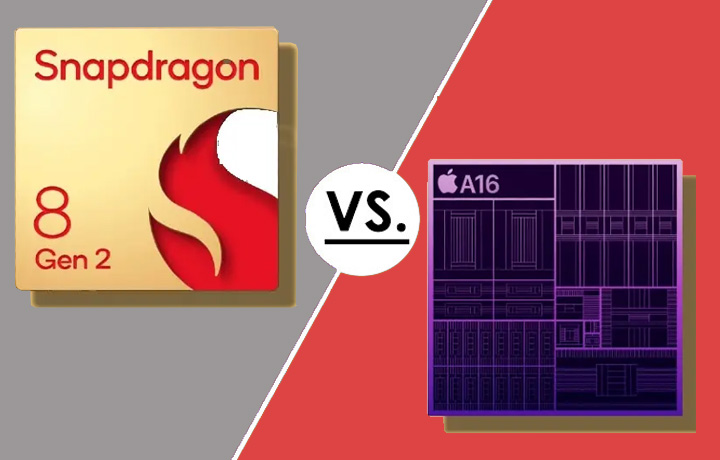Apple A16 vs. Snapdragon 8 Gen2: Who is The Winner?
In 2023, the battle for smartphone chip supremacy is fiercer than ever. Our Tech expert Daven dives deep into the raw performance and power efficiency of the two contenders: Apple’s A16 and Qualcomm’s Snapdragon 8 Gen2. With a unique approach to testing, Daven provides valuable insights into the architecture, CPU, GPU, battery life, and gaming performance of these flagship SoCs.
- Also:
- Google Pixel 8 Pro vs. Galaxy S23 Ultra: Google Takes the Crown in Key Areas
- Soundcore Motion X600 Portable Hi-Fi Speaker Review
Architecture:
Daven begins by explaining the architectural changes in both chips. Qualcomm’s Snapdragon 8 Gen2 introduces a unique CPU configuration with one Cortex X3 prime core, two A715 performance cores, two A710 performance cores, and three A510 efficiency cores. This change is a departure from the typical 1+3+4 layout and could impact multi-core performance and power consumption. Additionally, the inclusion of hardware ray tracing in the GPU is noted.
Apple’s A16, on the other hand, receives a more conservative update with minor CPU core design changes, but it utilizes the TSMC 4nm process for improved efficiency. The review discusses changes in cache design, the use of LPDDR5-6400 memory, and higher clock speeds.
Benchmark – CPU:
Daven proceeds to benchmark the CPU performance of both chips. Apple’s A16 retains its lead in CPU performance but with only incremental improvements over its predecessor, A15. He expresses disappointment in the limited gains given the transition to a new CPU design and better process technology.
Snapdragon 8 Gen2, however, impresses with its CPU efficiency. While it may not surpass Apple’s A16, it closes the gap significantly and outperforms previous Snapdragon generations, showcasing Qualcomm’s efforts to catch up.
Additionally, he delves into single-core power efficiency and explains that more performance cores can lead to better power efficiency, even if they run at lower frequencies, effectively solving thermal issues.
Benchmark – GPU:
In terms of GPU performance, Snapdragon 8 Gen2 shines, delivering about 30% better peak performance compared to A16 and its predecessor, Snapdragon 8+. The Tech expert emphasizes that this improvement in GPU performance is achieved without a significant increase in power consumption, showcasing Qualcomm’s efficiency gains.
However, it’s noted that Apple’s A16 disappoints in GPU performance, even potentially falling short of its predecessor, A15. This could be attributed to the unchanged GPU design and other factors like the introduction of LPDDR5 RAM.
- Galaxy S23 Ultra vs. iPhone 15 Pro Max: 9 Ways the Galaxy Reigns Supreme
- iPhone 15 Review: Evolution with Impressive Updates
Test – Battery Life:
Daven conducts a battery life test, showing that Android phones powered by Snapdragon 8 Gen2 provide longer battery life compared to A16-based iPhones. Android phone makers’ practice of including larger batteries compensates for the chips’ efficiency, making it possible to match iPhone battery life.
Test – Gaming (Genshin Impact):
When it comes to gaming performance ”Genshin Impact”, which is a CPU-intensive game. A16-based iPhones struggle with throttling and fail to outperform their A15-based counterparts, despite consuming more power. In contrast, Snapdragon 8 Gen2-powered Android phones deliver stable framerates with minimal throttling.
Android’s superior thermal management, including features like vapor chambers, is credited for the better gaming experience on Snapdragon 8 Gen2 devices, despite Apple’s chips being more power-efficient.
Android Tweaking:
Daven also showcases Android’s flexibility by using GFX tool to push the gaming performance further on a Xiaomi 13 Pro, achieving 4K gaming in Genshin Impact. This demonstrates the potential of Snapdragon 8 Gen2’s GPU.
- Xiaomi 13T Review: An Upper Midrange Phone With Flagship Camera Setup
- Xiaomi 13T vs. 13T Pro: In-Depth Review
Apple A16 vs. Snapdragon 8 Gen2 ” Pros And Cons”:
Apple A16:
Pros:
- Efficient CPU Design: While improvements over its predecessor may be incremental, the A16 maintains its lead in CPU performance, showcasing Apple’s refined architecture.
- TSMC 4nm Process: Utilizing TSMC’s 4nm process provides increased efficiency and performance, which contributes to the chip’s power efficiency.
- Larger L2 Cache and Higher Clock Speeds: These enhancements, along with LPDDR5-6400 memory, contribute to improved CPU performance.
Cons:
- Disappointing GPU Performance: The lack of substantial improvements in GPU performance, especially compared to the A15, is a notable drawback.
- Potential Overclocking Issues: The chip’s ability to boost to 3.46GHz, while providing peak performance, may result in unsustainable power consumption levels.
Qualcomm Snapdragon 8 Gen2:
Pros:
- Innovative CPU Configuration: The introduction of a unique CPU configuration, including an extra performance core, contributes to improved multi-core performance and efficiency.
- Efficient GPU Design: The Snapdragon 8 Gen2 boasts a significantly more efficient GPU, outperforming the A16 and its predecessor, without a substantial increase in power consumption.
- Improvement in Power Efficiency: Snapdragon 8 Gen2 shows significant strides in power efficiency, particularly when compared to its predecessor and even MediaTek’s flagship Dimensity 9200.
Cons:
- Potential for Reduced Efficiency at Low Frequencies: While having an extra performance core proves beneficial at mid to high clock speeds, the advantage narrows at lower frequencies, potentially impacting efficiency.
- Previous Generation Comparison: Although it outperforms the Snapdragon 8+, Snapdragon 8 Gen2’s performance gains may not be as substantial when compared to the Snapdragon 8+ released just six months earlier.
General Observations:
- Thermal Management and Gaming Performance (Android Advantage): Snapdragon 8 Gen2’s superior gaming performance on Android devices is attributed to Android OEMs’ effective thermal management solutions, such as vapor chambers, offering a notable advantage over iPhones.
- Potential for Android to Challenge Apple: Daven suggests that with the Snapdragon 8 Gen2, Team Android can potentially challenge Apple’s dominance in the smartphone SoC market, especially in the realm of gaming performance.
- Battery Life: Snapdragon 8 Gen2-powered Android devices demonstrate longer battery life compared to A16-based iPhones, indicating that Android OEMs’ practice of including larger batteries can compensate for efficiency differences.
- Flexibility and Customization on Android: Android’s flexibility is highlighted by showcasing the ability to tweak gaming settings on the Xiaomi 13 Pro, demonstrating the potential of Snapdragon 8 Gen2’s GPU.
- CPU Efficiency Gap Closing: While Apple maintains a lead in CPU performance, Snapdragon 8 Gen2’s significant improvement suggests that Qualcomm is actively working to close the gap.
Conclusion:
Apple A16 maintains its lead in CPU performance but disappoints in GPU performance. Qualcomm’s Snapdragon 8 Gen2 introduces innovative CPU design, demonstrates a significantly more efficient GPU, and makes notable strides in power efficiency.
On the other hand, Qualcomm’s Snapdragon 8 Gen2 is praised for closing the gap in CPU performance and excelling in GPU performance, particularly for gaming. Android’s thermal management further enhances the gaming experience.
- Shop On Amazon Using Our Links To Support Us:
- Buy Samsung Galaxy Z Fold 5 – Get your Xiaomi Mix Fold 3 here>>
- Amazon best sellers – Amazon most gifted – Amazon under $25






